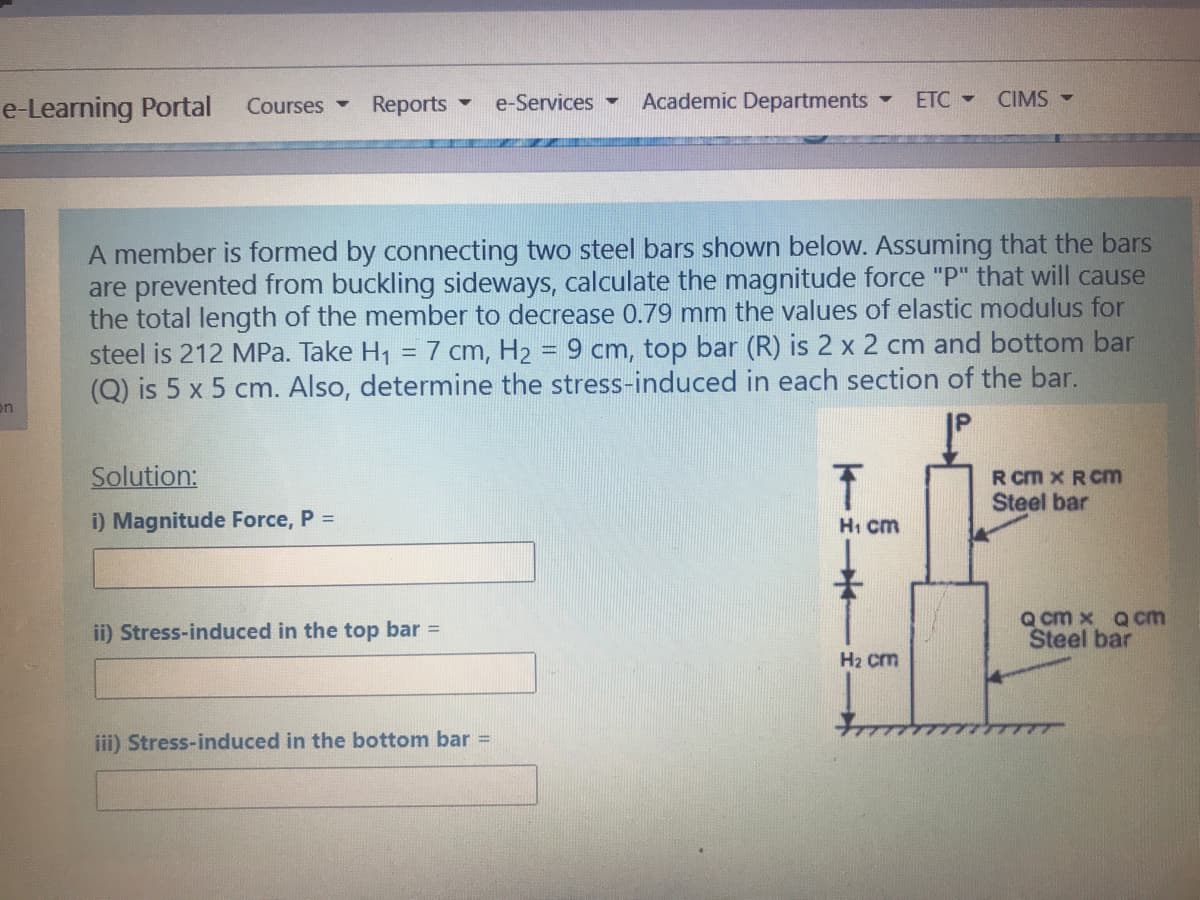A member is formed by connecting two steel bars shown below. Assuming that the bars are prevented from buckling sideways, calculate the magnitude force "P" that will cause the total length of the member to decrease 0.79 mm the values of elastic modulus for steel is 212 MPa. Take H1 = 7 cm, H2 = 9 cm, top bar (R) is 2 x 2 cm and bottom bar (Q) is 5 x 5 cm. Also, determine the stress-induced in each section of the bar. %3D %3D Solution: R cm x R Cm Steel bar i) Magnitude Force, P = Hi cm ii) Stress-induced in the top bar = Q cm x Qcm Šteel bar H2 cm iii) Stress-induced in the bottom bar =
A member is formed by connecting two steel bars shown below. Assuming that the bars are prevented from buckling sideways, calculate the magnitude force "P" that will cause the total length of the member to decrease 0.79 mm the values of elastic modulus for steel is 212 MPa. Take H1 = 7 cm, H2 = 9 cm, top bar (R) is 2 x 2 cm and bottom bar (Q) is 5 x 5 cm. Also, determine the stress-induced in each section of the bar. %3D %3D Solution: R cm x R Cm Steel bar i) Magnitude Force, P = Hi cm ii) Stress-induced in the top bar = Q cm x Qcm Šteel bar H2 cm iii) Stress-induced in the bottom bar =
Elements Of Electromagnetics
7th Edition
ISBN:9780190698614
Author:Sadiku, Matthew N. O.
Publisher:Sadiku, Matthew N. O.
ChapterMA: Math Assessment
Section: Chapter Questions
Problem 1.1MA
Related questions
Question

Transcribed Image Text:e-Learning Portal
Courses -
Reports
e-Services
Academic Departments
ETC -
CIMS -
A member is formed by connecting two steel bars shown below. Assuming that the bars
are prevented from buckling sideways, calculate the magnitude force "P" that will cause
the total length of the member to decrease 0.79 mm the values of elastic modulus for
steel is 212 MPa. Take H1 = 7 cm, H2 = 9 cm, top bar (R) is 2 x 2 cm and bottom bar
(Q) is 5 x 5 cm. Also, determine the stress-induced in each section of the bar.
on
Solution:
R cm x RCm
Steel bar
i) Magnitude Force, P =
Hi cm
ii) Stress-induced in the top bar =
Q cm x Qcm
Steel bar
H2 cm
iii) Stress-induced in the bottom bar =
Expert Solution
This question has been solved!
Explore an expertly crafted, step-by-step solution for a thorough understanding of key concepts.
This is a popular solution!
Trending now
This is a popular solution!
Step by step
Solved in 4 steps with 4 images

Knowledge Booster
Learn more about
Need a deep-dive on the concept behind this application? Look no further. Learn more about this topic, mechanical-engineering and related others by exploring similar questions and additional content below.Recommended textbooks for you

Elements Of Electromagnetics
Mechanical Engineering
ISBN:
9780190698614
Author:
Sadiku, Matthew N. O.
Publisher:
Oxford University Press

Mechanics of Materials (10th Edition)
Mechanical Engineering
ISBN:
9780134319650
Author:
Russell C. Hibbeler
Publisher:
PEARSON

Thermodynamics: An Engineering Approach
Mechanical Engineering
ISBN:
9781259822674
Author:
Yunus A. Cengel Dr., Michael A. Boles
Publisher:
McGraw-Hill Education

Elements Of Electromagnetics
Mechanical Engineering
ISBN:
9780190698614
Author:
Sadiku, Matthew N. O.
Publisher:
Oxford University Press

Mechanics of Materials (10th Edition)
Mechanical Engineering
ISBN:
9780134319650
Author:
Russell C. Hibbeler
Publisher:
PEARSON

Thermodynamics: An Engineering Approach
Mechanical Engineering
ISBN:
9781259822674
Author:
Yunus A. Cengel Dr., Michael A. Boles
Publisher:
McGraw-Hill Education

Control Systems Engineering
Mechanical Engineering
ISBN:
9781118170519
Author:
Norman S. Nise
Publisher:
WILEY

Mechanics of Materials (MindTap Course List)
Mechanical Engineering
ISBN:
9781337093347
Author:
Barry J. Goodno, James M. Gere
Publisher:
Cengage Learning

Engineering Mechanics: Statics
Mechanical Engineering
ISBN:
9781118807330
Author:
James L. Meriam, L. G. Kraige, J. N. Bolton
Publisher:
WILEY